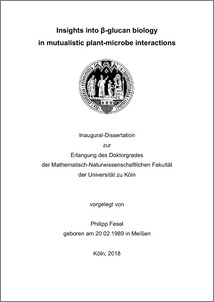Fesel, Philipp
(2018).
Insights into β-glucan biology in mutualistic plant-microbe interactions.
PhD thesis, Universität zu Köln.

![[img]](https://kups.ub.uni-koeln.de/style/images/fileicons/application_pdf.png)  Preview |
|
PDF
Dissertation_Philipp_Fesel_Published.pdf
- Accepted Version
Download (6MB)
|
Abstract
Plants are constantly surrounded by pathogenic and mutualistic microbes, for example fungi. To defend against fungal invaders plants rely on the innate immunity of each cell which is activated in response to the perception of microbe-associated molecular patterns, so called MAMPs, by specific plant surface receptors. Fungal cell wall derived polysaccharides like branched β-1,3/1,6-glucans are perceived as MAMPs and identify a fungal cell as non-self. The fungal cell wall is a highly dynamic organelle that is constantly reshaped to tailor its structure and composition to circumvent the activation of the plant defense while ensuring cell wall integrity especially during plant colonization.
This study aimed to characterize proteins of the mutualistic root endophyte Serendipita indica and its experimental host plant A. thaliana that are engaged in β-glucan biology. The WSC-domain containing lectin WSC3, a member of a multigene family in S. indica is transcriptionally induced during plant colonization and in contact with a second fungus. The fusion protein WSC3-GFP localizes to the cell wall of S. indica, reduces the exposure of β-1,3-glucan and increases cell wall stress resistance in the yeast Pichia pastoris. Isothermal titration calorimetry revealed that WSC3-His binds the MAMP laminarin, a branched β-1,3/1,6-glucan and is able to agglutinate various fungal cells. Furthermore WSC3-His efficiently competes with the unknown plant receptor and thus prevents the induction of the production of reactive oxygen species (ROS) by laminarin but does not increase colonization of barley roots by S. indica. Additionally the secreted β-1,6-glucan specific lectin FGB1 of S. indica was shown to universally suppress ROS production in barley in response to the MAMPs laminarin, chitin and flg22. The investigation of the laminarin-induced ROS production in A. thaliana revealed great natural variation among 100 tested accession. A genome wide association screen identified several genetic loci that are potentially involved in laminarin-triggered defense responses in A. thaliana.
Collectively these results suggest that WSC3 might act as a structural component of the fungal cell wall to maintain cell wall integrity while FGB1 is acting as universal suppressor of MAMP-triggered ROS production. Both proteins underline the pivotal role of the fungal cell wall in general and especially of β-glucans during plant-microbe interactions. The responsiveness of A. thaliana to laminarin is subject of great natural variation and potentially represents a multigenetic trait.
| Item Type: |
Thesis
(PhD thesis)
|
| Translated abstract: |
| Abstract | Language |
|---|
| Pflanzen sind fortwährend von pathogenen und mutualistischen Mikroorganismen, zum Beispiel Pilzen, umgeben. Um sich gegen pilzliche Infektionen zu schützen, vertrauen Pflanzen auf die Immunität jeder einzelnen Zelle. Sobald über Oberflächenrezeptoren mikroorganismenspezifische Signalmoleküle, so genannte MAMPs, wahrgenommen werden, wird eine Abwehrreaktion ausgelöst. Dabei werden z.B. verzweigte β-1,3/1,6-Glukane aus der Pilzzellwand als MAMPs von Pflanzenrezeptoren detektiert, da diese die Pilzzelle als fremdartige Struktur identifizieren. Die Pilzzellwand ist ein hochdynamischer Zellbestandteil, dessen Struktur und Zusammensetzung sich permanent verändert, um sowohl eine pflanzliche Abwehrreaktion zu vermeiden als auch die Stabilität zu gewährleisten.
Das Ziel dieser Untersuchung war die Identifizierung von Proteinen des mutualistischen Wurzelendophyten Serendipita indica und dessen Wirtspflanze Arabidopsis thaliana, die beim Schutz und der Erkennung von β-Glukanen eine Rolle spielen. Das S. indica Lektin WSC3 ist pflanzen- und pilzresponsiv transkriptionell induziert und lokalisiert an die S. indica Zellwand. In der Hefe Pichia pastoris wird WSC3-His in die Zellwand integriert und erhöht dort die Widerstandsfähigkeit gegenüber den zellwandschädlichen Substanzen Kongorot und Calcofluor Weiß. Es konnte weiterhin gezeigt werden, dass WSC3-His verzweigte β-1,3/1,6-Glukane binden kann und so zur Agglutination von Pilzzellen führt und zur Unterdrückung von β-1,3/1,6-Glukan-induzierten Abwehrreaktionen in Pflanzen beiträgt. Zusätzlich konnte gezeigt werden, dass das β-1,6-Glukan bindende Lektin FGB1 in der Lage ist, die von verschiedenen pilzlichen und bakteriellen MAMPs ausgelösten Abwehrreaktionen in Pflanzen zu unterdrücken. Bei der Untersuchung der β-1,3/1,6-Glukan-induzierten Abwehrreaktion konnten beachtliche Unterschiede, hinsichtlich der Stärke der induzierten Abwehrreaktionen, zwischen natürlichen A. thaliana Ecotypen festgestellt werden, die durch eine genomweiten Assoziationsstudie zur Identifizierung von möglichen Kandidaten genutzt wurden.
Zusammenfassend kann festgehalten werden, das WSC3 möglicherweise ein strukturgebender Komponent ist, der zur Stabilisierung der S. indica Zellwand beiträgt, während FGB1 als universeller Suppressor von MAMP-induzierten Abwehrreaktionen agiert. Die beachtlichen Unterschiede zwischen den A. thaliana Ecotypen hinsichtlich der Reaktion auf Laminarin und die Ergebnisse der genomweiten Assoziationsstudie legen Nahe, dass mehrere Gene an dieser Abwehrreaktion beteiligt sind. | German |
|
| Creators: |
| Creators | Email | ORCID | ORCID Put Code |
|---|
| Fesel, Philipp | ph.fesel@gmail.com | UNSPECIFIED | UNSPECIFIED |
|
| URN: |
urn:nbn:de:hbz:38-80067 |
| Date: |
2018 |
| Language: |
English |
| Faculty: |
Faculty of Mathematics and Natural Sciences |
| Divisions: |
Faculty of Mathematics and Natural Sciences > Department of Biology > Botanical Institute |
| Subjects: |
Life sciences |
| Uncontrolled Keywords: |
| Keywords | Language |
|---|
| B-Glucan | English | | Serendipita indica | English | | Plant immunity | English |
|
| Date of oral exam: |
19 December 2017 |
| Referee: |
| Name | Academic Title |
|---|
| Zuccaro, Alga | Prof. Dr. | | Schulze-Lefert, Paul | Prof. Dr. |
|
| Refereed: |
Yes |
| URI: |
http://kups.ub.uni-koeln.de/id/eprint/8006 |
Downloads per month over past year
Export
Actions (login required)
 |
View Item |


